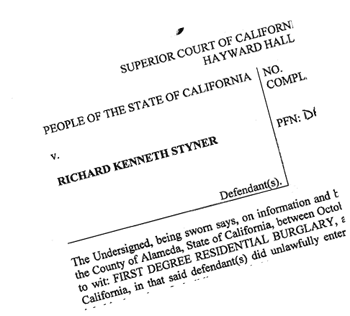 Rick Styner case shows how criminal defendants can be easily railroaded
Rick Styner case shows how criminal defendants can be easily railroaded
Yesterday I went to court to listen to the the third part of the preliminary hearing on the case against Rick Styner, the San Leandro High School teacher accused of possession of child pornography. Unfortunately I missed the first two days of the hearing and the media coverage by the BANG papers has been atrocious.
Yesterday, the judge ruled there was sufficient cause to go to trial on charges of stealing a pair of Amy McNamara Furtado’s panties and of possessing child pornography (not for anything found in his schools computer, mind you, but for 10 files found stored in the basement of his house, that had last been accessed in 2002).
With respect to the burglary, the original allegations were that Styner went to Amy McNamara Furtado’s home, laid out some of her running gear and took pictures of it. The problem was that that, in itself, does not constitute “burglary”. For a burglary to exist, Styner would have had to enter the house intending to commit a felony or a theft. But no such thing was originally alleged.
Amy is now claiming that a pair of the sports panties that Styner photographed are missing. While that claim may not be particularly credible, in our system of law the judge doesn’t get to make that determination. It’s up to the juries to decide on the credibility of a witness. The question that the judged had to consider was “are there rational grounds to believe” that Styner went to the house with the intention to steal the panties. The judged made it clear that he wanted the defense attorney to argue that there wasn’t one, he gave him plenty of opportunities. I don’t know why the defense attorney didn’t simply say “just because panties are missing, it doesn’t mean they were taken, Amy could have just misplaced them, left them at the gym, or they could have gone wherever socks go” and “why would Styner take pictures of the panties if he planned to steal them?”. I think that would have been enough for the judge to kill this charge.
But the defense attorney didn’t make the arguments, and the judge let the charges stand. The judge, however, implied much that it’s unlikely that the inference could be used at trial where the standard of proof is much more substantial. But the system is such that it takes very little evidence to make it to trial in the first place.
The porn charges are more interesting. I wasn’t there for the first two days of the prelim, but Styner is not being tried because of any alleged child pornography found on his school computer. This suggests to me that there wasn’t any child pornography in the school computer at all, which is what I concluded when I looked at the charges last summer. However, making up that claim did give the Police the opportunity to get a warrant to search Styner’s house. In the basement, they found a number of computer parts. Among them there were two hard drives that had a total of ten short videos and photos of what, to the judge, looked like child pornography. Not having seen the videos, I’ll assume that they were. Again, at this level of the procedures, you don’t need much in the way of proof.
The question that the defense attorney had to raise then, was whether there is any evidence that Styner knowingly possessed the files. The hard drives were in the basement of his house, but were they his? Given that Styner was a computer geek that question is actually quite important. I live with a computer geek myself, and there are lots of computer parts – including hard drives – all over my house. My husband gets them from friends who are throwing them away or from work (or nearby offices at work), meaning to do something with them. Often times he doesn’t get to it, and there they languish. I know that in many cases he has no idea what’s on the computer drives and that could very well be true with Styner. But his attorney failed to make that point.
Even if those particular drives did belong to Styner – if, for example, the Prosecution could show that there were files in the hard drives that could clearly be attributed to him – there is another just as pressing question: “did Styner know he had them”? It’s common for men to download porn, and often times they do it on big batches, rather than selecting specific pieces. When you download files in batches or in .zip files, you may end up downloading files you never intended to get. Unless you looked at them, you wouldn’t know what they had in them. Again, I did not hear the defense attorney raising this point.
—
The Styner case shows how important a good defense attorney is – but also how any of us could be so easily railroaded by the Police and a prosecutor’s office that has no regards for justice.
Rick Styner will now have to chose between making a plea or bankrupting himself completely and going to trial. The latter will probably involve having to discuss the intimate details of his relationship with Amy McNamara Furtado, which I’m sure he fears will embarrass his wife and adds to the pressures to plea bargain.
What is happening to him could happen to *any* of us.
**Full disclosure: I’ve met Rick Styner once, yesterday at the prelim hearing. I greeted him and told him I was sorry and that I thought the charges looked very weak. I’ve met his wife Mary Styner also once, yesterday. I’ve met Amy Furtado a number of times when she was principal at San Leandro High School. I had no particular opinion of her. The three of them were friends of SLT’s facebook page when this sage started, Amy has since defriended me.

